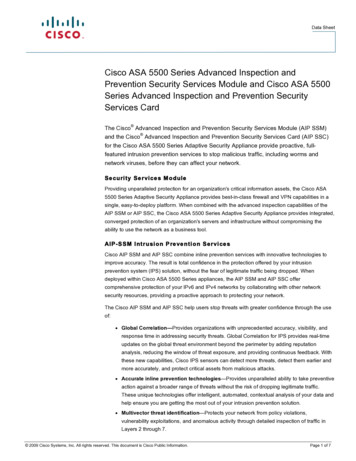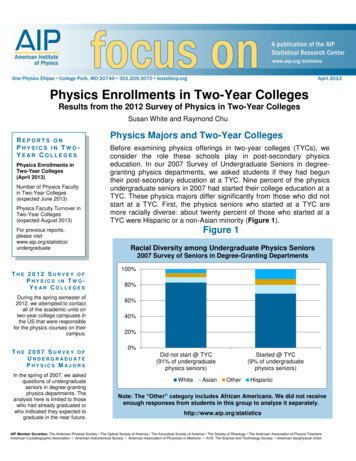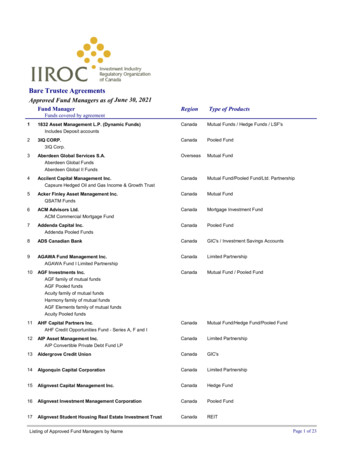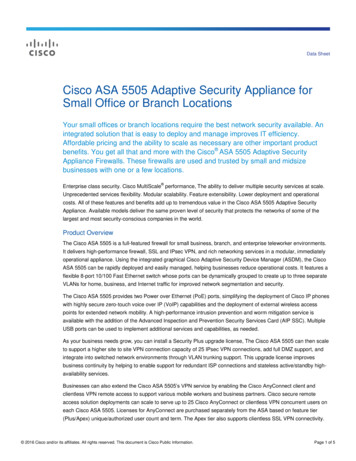
Transcription
www.aip.org/statisticsSeptember 2010One Physics Ellipse College Park, MD 20740 301.209.3070 stats@aip.orgHigh School Physics TextbooksResults from the 2008-09 Nationwide Survey of High School Physics TeachersCasey Langer Tesfaye & Susan WhiteREPORTS ONHIGH SCHOOLPHYSICSHigh School PhysicsAvailability (April 2010)High School PhysicsCourses & Enrollments(August 2010)High School PhysicsTextbooks (September2010)Who Teaches High SchoolPhysics (November 2010)Under-RepresentedMinorities in High SchoolPhysics (March 2011)Females in High SchoolPhysics (July 2011)THE 2008-09NATIONWIDE SURVEYOF HIGH SCHOOLPHYSICS TEACHERSDuring the 2008-09 academicyear, we contacted arepresentative national sampleof about 3,600 public andprivate high schools across theUS to inquire about physicsavailability and offerings. Thesereports describe our findings.What textbooks are physics teachers using? How well do they rate? Thetextbooks used by high school physics teachers in the US have evolved alongwith the changing demands of physics classes. In this report, we examine theteachers’ ratings of the textbooks they use, by type of physics class, and theevolution of textbooks used for each type of physics class.Figure 1Teachers’ Ratings of Textbooks for Regular Physics,US High Schools, 2008–2009How well did this textbook work for this course?Course:Regular PhysicsQuite well%Not very well orNot well at all%Somewhat well%Conceptual Physics(Hewitt / AddisonWesley)444313Physics: Principles withApplications (Giancoli /Prentice Hall)434413Holt Physics (Serway,Faughn / HoltMcDougal)Physics Principles andProblems (Zitzewitz /McGraw Hill)383450491217Ratings based on a four-point scale: Quite well, Somewhat well, Not very well, Not well at allDifferences less than 5% are not statistically significanthttp://www.aip.org/statisticsAIP Member Societies: The American Physical Society The Optical Society of America The Acoustical Society of America The Society of Rheology The American Association of Physics TeachersAmerican Crystallographic Association American Astronomical Society American Association of Physicists in Medicine AVS The Science and Technology Society American Geophysical Union
focus on High School Physics TextbooksPage 2Since we started tracking textbook use in regular physics classes in 1987,Physics Principles and Problems (Zitzewitz) has been the most widely usedtextbook. A couple of books have gained popularity in recent years, and HoltPhysics (Serway et al.) is now as widely used as as Zitzewitz, and ConceptualPhysics (Hewitt) has also become significantly more common.Of these three dominant regular physics texts, Hewitt rates the highest amongteachers (Figure 1), and Zitzewitz rates the lowest. Physics: Principles withApplications (Giancoli) also rated highly with teachers but is not used by asmany teachers as the other three.Table 1Most Widely Used Physics Textbooks for Regular Physics,US High Schools, 1987–2009While the vast majorityof physics teachersrelies primarily on thetextbooks representedin this report, someteachers don’t use atextbook for theirclass, and others havereplaced their physicstextbooks with anincreasingly commonarray of onlineresources.% UsingHolt Physics (Serway,Faughn, Holt McDougal)Physics Principles andProblems (Zitzewitz /McGraw Hill)Conceptual Physics(Hewitt / Addison-Wesley)Physics: Principles withApplications (Giancoli /Prentice ----------* Less than 5%--- Not separately ratedDifferences less than 5% are not statistically significanthttp://www.aip.org/statisticsThe changes in the type of textbooks used by regular physics classes reflectchanges in high school physics enrollments. Total enrollments in high schoolphysics classes have doubled since our surveys began in 1987. However,enrollments in separate conceptual physics classes have increasedsubstantially, while enrollments in regular physics classes have remained fairlystable. Regular physics is still the most common type of physics class, but theuse of conceptual physics texts in regular physics has grown significantly.These changes can be seen in Figure 2.September 2010AIP Statistical Research Center
focus on High School Physics TextbooksPage 3Figure 2Physics Enrollment in US High Schoolsby Type of Course, 1987 – 2009(numbers in 1,000s)More regular physicsclasses are usingconceptual physicstextbooks. Conceptualphysics enrollmentsare on the rise. Physics First was explicitly included in the list of courses for the first time on the2008-09 survey*Regular course taught using conceptual texthttp://www.aip.org/statisticsAs you can see in Table 2, the dominant book for the growing field ofconceptual physics courses is Conceptual Physics (Hewitt). Of theteachers using it, 90% reported that it worked somewhat or quite well fortheir courses. A much smaller proportion of teachers use PhysicsPrinciples and Problems (Zitzewitz) for their conceptual physicscourses, and they were much less pleased: half of the teachers usingthis book reported that it worked not very well or not well at all for theirclasses.This is the first survey to specifically address textbooks for Physics Firstclasses, and Conceptual Physics (Hewitt) is clearly the dominant bookfor the class. It is used by 74% of the Physics First teachers.AIP Statistical Research CenterSeptember 2010
focus on High School Physics TextbooksPage 4Table 2Most Widely Used Physics Textbooks for Conceptual Physics,US High Schools, 1987–2009% Using2008 2005 2001 1997 1993Course:Physics First*Conceptual Physics--------(Hewitt / Addison-Wesley) 74%Physics for Non-Science Students or Conceptual PhysicsConceptual Physics(Hewitt / Addison-Wesley) 80% 76% 75% 74% 79%Physics Principles andProblems (Zitzewitz /McGraw Hill)7%*6%7%8%19901987------75%27%7%28% Physics First was explicitly included in the list of courses for the first time on the 2008-09 survey* Less than 5%--- Not separately ratedDifferences less than 5% are not statistically significanthttp://www.aip.org/statisticsFigure 3Teachers’ Ratings of Textbooks for Conceptual Physics,US High Schools, 2008–2009How well did this textbook work for this course?Teachers find thatHewitt’s text works wellfor conceptual physicscourses.Course:Physics FirstQuite well%Conceptual Physics(Hewitt / Addison-Wesley)Somewhat well%56Not very well orNot well at all%3410Physics for Non-Science Studentsor Conceptual PhysicsConceptual Physics(Hewitt / Addison-Wesley)Physics Principles andProblems (Zitzewitz /McGraw Hill)61183132850Ratings based on a 4 point scale: Quite well, Somewhat well, Not very well, Not well at allDifferences less than 5% are not statistically significanthttp://www.aip.org/statisticsSeptember 2010AIP Statistical Research Center
Page 5focus on High School Physics TextbooksThe most common books used for First Year Honors, Accelerated or Giftedand Talented Physics classes continue to be Holt Physics (Serway et al.),Physics Principles and Problems (Zitzewitz) and Physics: Principles withApplications (Giancoli).Table 3Most Widely Used Textbooks for First Year Honors,Accelerated or Gifted and Talented Physics,US High Schools, 1987–2009% UsingHolt Physics (Serway,Faughn, Holt McDougal)Physics Principles andProblems (Zitzewitz /McGraw Hill)Physics: Principles withApplications (Giancoli /Prentice Hall)College Physics (Serway,Faughn, Vuille / Brooks /Cole)Conceptual Physics(Hewitt / ----8%8%9%*8%6%****7%Although Zitzewitz iswidely used, it is not ashighly rated as othertexts.---** Less than 5%--- Not separately ratedDifferences less than 5% are not statistically �s text is very highly rated (Figure 4). Not only did 59% of teacherssay that this textbook worked quite well for their courses, only 9% said that itworked not very well or not well at all. Serway and Faughn’s text was ratedquite highly as well. Two less widely used books, College Physics (Serway etal.) and Conceptual Physics (Hewitt), rated highly enough to demonstratepotential for growth.Although the Zitzewitz text received few poor ratings for the course, itreceived the smallest proportion of strongly positive response. This was thelowest rating of all of the textbooks used for Honors, Accelerated or Giftedand Talented Physics.AIP Statistical Research CenterSeptember 2010
focus on High School Physics TextbooksPage 6Figure 4Teachers’ Ratings of Textbooks for First Year Honors,Accelerated or Gifted and Talented Physics,US High Schools, 1987–2009How well did this textbook work for this course?Quite wellCourse:%First Year Honors, Accelerated orGifted and Talented PhysicsTeachers report thatmost of these textswork well forHonors Physics.Physics: Principleswith Applications(Giancoli / PrenticeHall)59College Physics(Serway, Faughn,Vuille / Brooks /Cole)Physics Principlesand Problems(Zitzewitz / McGrawHill)3248Holt Physics(Serway, Faughn,Holt McDougal)Conceptual Physics(Hewitt / AddisonWesley)Not very well orNot well at all%Somewhat well%454542304746569781214Ratings based on a 4 point scale: Quite well, Somewhat well, Not very well, Not well at allDifferences less than 5% are not statistically significanthttp://www.aip.org/statisticsAdvanced Placement Physics classes rose in prevalence and prominencein the 1990s. AP Physics B is an introductory course that relies on algebraand trigonometry, and AP Physics C is an intensely analytical course thatrelies heavily on calculus and often stretches across two academic years.The material in AP Physics C often helps to form a foundation in physics forstudents who major in science and engineering in college.September 2010AIP Statistical Research Center
Page 7focus on High School Physics TextbooksThe two most widely used textbooks for AP Physics B continue to bePhysics: Principles with Applications (Giancoli) and College Physics(Serway et al.). Both rated quite highly among physics teachers. Of thephysics teachers responding, only 3% and 5%, respectively, reportedthat they worked not very well or not well at all, and 64% of physicsteachers reported that the books worked quite well for their classes.AP Physics C texts focus on solutions to challenging problems in bothmechanics and electricity and magnetism. Two widely used texts for APPhysics C classes were Physics for Scientists & Engineers (Serway etal.) and Physics (Halliday et al.). The texts are used in about a quarterof AP Physics C classes.Table 4Most Widely Used Textbooks for AP Physics,US High Schools, 1987–2009% UsingCourse:20082005200119971993Advanced Placement Physics BPhysics: Principles withApplications (Giancoli /Prentice Hall)36%35%33%27%28%College Physics (Serway,Faughn, Vuille / Brooks /Cole)26%20%25%24%10%College Physics (Wilson,Buffa, Lou / Prentice Hall)6%Physics (Walker / Pearson)6%Essentials of Physics(Cutnell, Johnson / Wiley)5%19%15%Physics for Scientists &Engineers (Serway, Jewett /Cengage Learning)19%------------Physics (Halliday, Resnick,Krane / Wiley)7%45%47%41%39%9%---Advanced Placement Physics CAP Physics C isintense, analytical andcalculus based. It oftenextends to one and ahalf or two schoolyears.* Less than 5%--- Not separately ratedDifferences less than 5% are not statistically significanthttp://www.aip.org/statisticsAIP Statistical Research CenterSeptember 2010
focus on High School Physics TextbooksPage 8Figure 5Teachers’ Ratings of Textbooks for AP Physics,US High Schools, 2008–2009How well did this textbook work for this course?Quite wellCourse:%Advanced Placement Physics BNot very well orNot well at all%Somewhat well%Physics: Principleswith Applications(Giancoli /Prentice Hall)64333College Physics(Serway, Faughn,Vuille / Brooks /Cole)64315Physics (Walker /Pearson)61Essentials ofPhysics (Cutnell,Johnson / Wiley)47College Physics(Wilson, Buffa,Lou / PrenticeHall)46Advanced Placement Physics CPhysics forScientists &Engineers(Serway, Jewett /CengageLearning)Physics (Halliday,Resnick, Krane /Wiley)2613485459702769313Ratings based on a four-point scale: Quite well, Somewhat well, Not very well, Not well at allDifferences less than 5% are not statistically significanthttp://www.aip.org/statisticsSeptember 2010AIP Statistical Research Center
focus on High School Physics TextbooksPage 9Survey MethodologyIn the fall of 2008, we contacted a representative sample of over 3,600high schools in the US, both public and private, to determine whether ornot physics was taught there. We received responses from over 99% ofthe schools. For the schools which indicated they were offering physics,we obtained contact information for the teachers. In the spring of 2009,we contacted each of the teachers who were thought to be teachingphysics. We received responses from over 2,500 teachers (a 62%response rate). Our findings are based on their responses.For a copy of the principal or teacher questionnaire, please contactSusan White at swhite@aip.org.We were able to conduct this research only with the gracious help ofthe more than 6,000 people who provided responses, including anadministrator at each school and each of the teachers who responded.We are deeply grateful for their assistance and their time.This marks the seventh time we have conducted a survey examiningphysics in US high schools. The first six studies were directed byMichael Neuschatz, who retired from AIP in 2008. We hope to continuethe tradition of excellent work in this area that he began.AIP Statistical Research CenterSeptember 2010
textbooks used by high school physics teachers in the US have evolved along with the changing demands of physics classes. In this report, we examine the teachers' ratings of the textbooks they use, by type of physics class, and the evolution of textbooks used for each type of physics class. Figure 1










